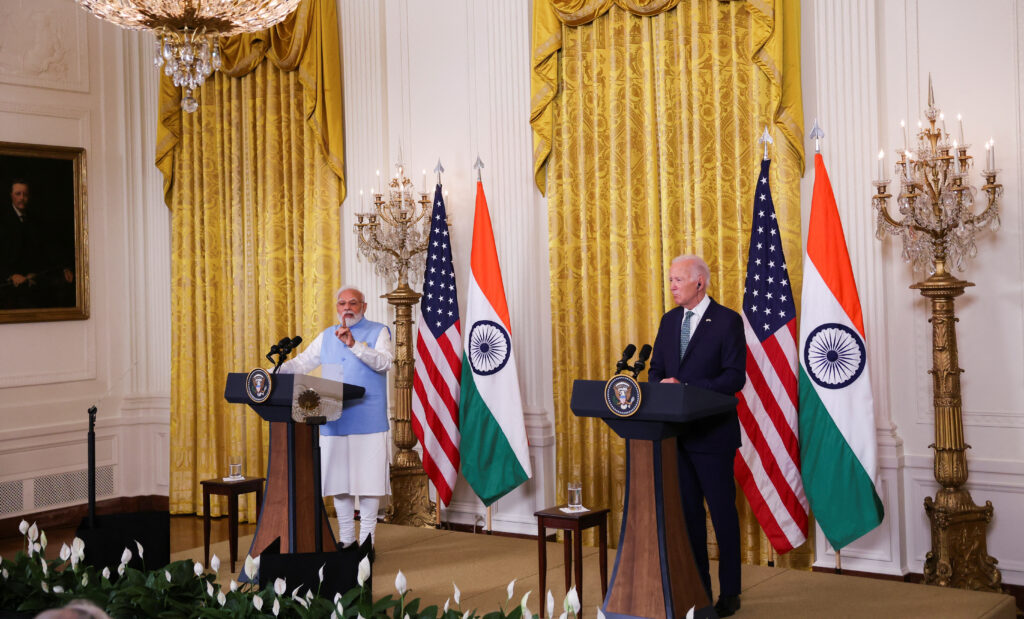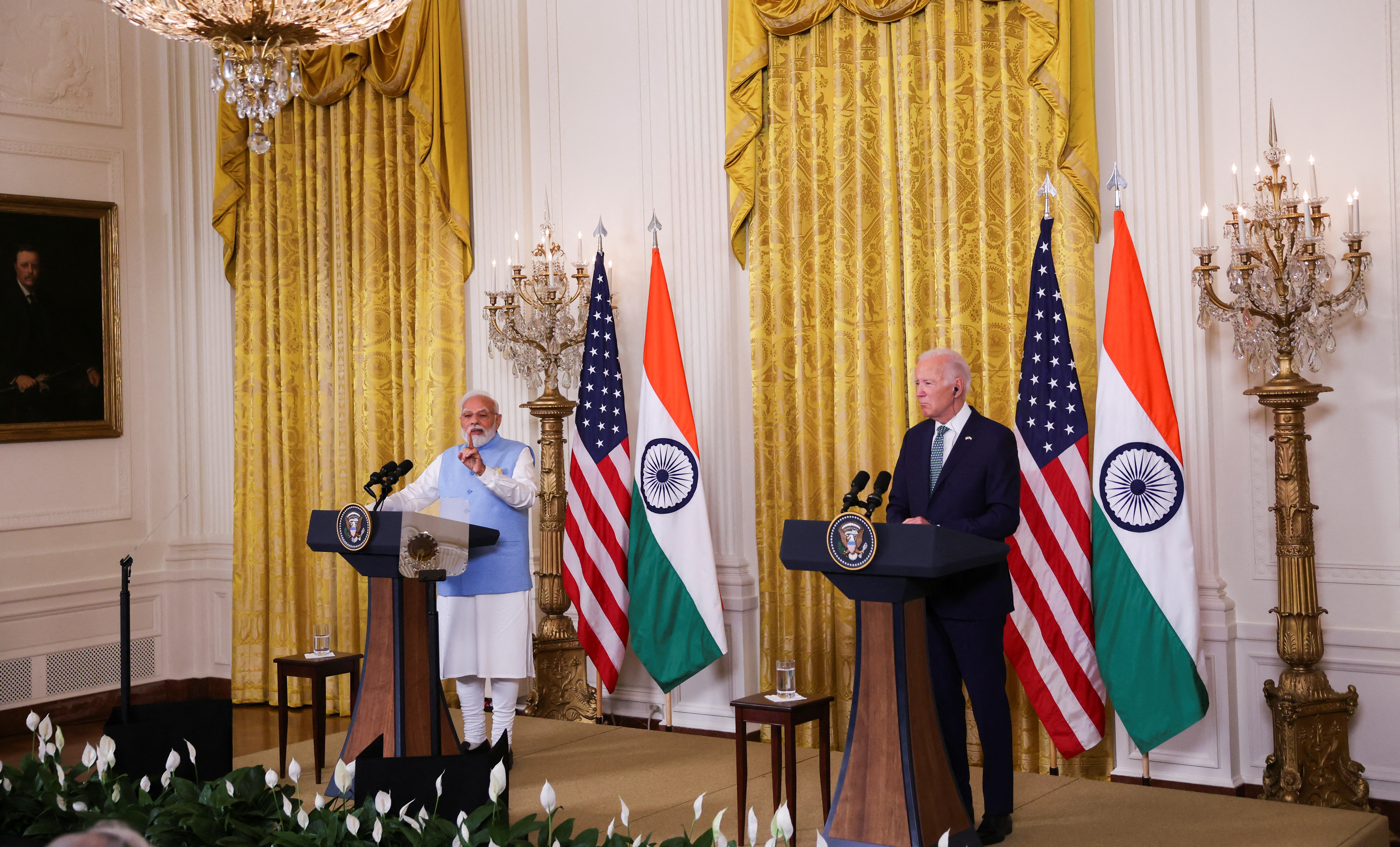
U.S.-India Relations Forge New Frontiers with Technology and Defense Deals
Prachi Mishra
The recent visit of Indian Prime Minister Modi to the United States resulted in several key technology deals, MoUs, and collaborations. With growing penetration of emerging technologies in the socio-economic-political and security fabric of nation states, it is imperative for global leaders to come together and work on challenges that impact everyone.
The bilateral ties between the United States and India have taken a significant leap forward with Prime Minister Narendra Modi and President Joe Biden unveiling a series of groundbreaking technology and defense agreements. During his address to the joint session of the U.S. Congress, PM Modi emphasised the global benefits of collaboration on semiconductors and critical minerals, highlighting the role it plays in enhancing the resilience and diversity of supply chains. With defense cooperation blossoming over the years, the United States has emerged as one of India\’s key defense partners.

Former diplomats and analysts are optimistic about the future of this relationship, foreseeing strengthened ties and more lucrative deals on the horizon. Atul Keshap, President of the U.S.-India Business Council and former charge d\’affaires at the U.S. Embassy in New Delhi, expects the expansion to extend to military agreements, heralding positive outcomes for both nations, democracy, and the Indo-Pacific region as a whole. The remarkable scope of the announced deliverables has impressed observers and sparked confidence in the trajectory of U.S.-India relations. Some key highlights are showcased below;
Institution building – Both President Biden and Prime Minister Modi agree that as their collaboration grows, technology will become increasingly important. The founding of the Initiative on Critical and Emerging Technology (iCET) in January 2023 was welcomed by the leaders as a significant turning point for relations between the United States and India. They urged institutions of higher learning, corporations, and governments to carry out their common goal for the strategic technological partnership. The leaders reaffirmed their commitment for the United States and India to support an open, approachable, safe, and trust-based digital ecosystem that upholds their shared ideals and democratic institutions.
Space – By the end of 2023, NASA and ISRO will have created a strategic plan for working together on human spaceflight. Indian astronauts will receive advanced training at NASA\’s Johnson Space Center in Houston, Texas, with the intention of staging a cooperative mission to the International Space Station in 2024. This news was applauded by both the US and India. The NASA-ISRO Synthetic Aperture Radar (NISAR) satellite was sent to the U.R. Rao Satellite Center in Bengaluru, India, and NISAR\’s launch from India in 2024 was anticipated. The leaders praised India\’s Space Policy – 2023 and urged greater commercial cooperation between the American and Indian corporate sectors along the full value chain of the space economy, as well as to resolve export restrictions and promote knowledge transfer. The Artemis Accords, which establish a shared vision of space exploration for the benefit of all humanity, were signed by India, and President Biden was very grateful for this.
Tech trade – Both India and the US applauded the interagency-led Strategic Trade Dialogue\’s commencement in June 2023 and instructed both parties to make ongoing efforts to resolve export restrictions, look for measures to boost high technology trade, and ease technology transfer between the two nations.
Semiconductors and supply chains – A Memorandum of Understanding (MoU) on Semiconductor Supply Chain and Innovation Partnership as a significant milestone in coordinating the semiconductor incentive programs of India and the US was highly talked about. This will support the growth of commercial possibilities, research, talent, and skills. The decision of Micron Technology, Inc. to work with the Indian government to invest up to $825 million in the construction of a new semiconductor assembly and testing plant in India was applauded by the leaders. Up to 5,000 new direct jobs and 15,000 community work possibilities might be created over the course of the next five years thanks to the joint investment, estimated at $2.75 billion. The leaders also praised Lam Research\’s proposal to expedite India\’s aspirations for semiconductor education and workforce development by training 60,000 Indian engineers through its Semiverse Solution virtual manufacturing platform, as well as a statement from Applied Materials.
Telecom – Two Joint Task Forces on Advanced Telecommunications were established by the leaders, with a focus on Open RAN (O-RAN) and research and development in 5G/6G technologies. The Bharat 6G Alliance in India and the Next G Alliance in the United States will be in charge of the public-private collaboration between vendors and operators. With the support of funding from the U.S. International Development Finance Corporation (DFC), both India and the US are collaborating on Open RAN field trials and rollouts, including scaled deployments, with operators and vendors from both markets. The leaders praised Indian businesses\’ involvement in the American \”rip and replace\” program. They supported an ambitious plan for 6G networks that called for collaboration on standards, easier access to chipsets for system development, and the creation of cooperative R&D initiatives.
Quantum tech – The creation of a joint Indo-U.S. Quantum Coordination Mechanism to promote cooperation between business, academia, and government, as well as their efforts to reach a comprehensive Quantum Information Science and Technology agreement, was hailed by President Biden and Prime Minister Modi. The Quantum Economic Development Consortium and the Quantum Entanglement Exchange both warmly welcome India\’s involvement in order to promote professional and business interactions with other prominent, quantum-minded countries. Programs for quantum training and exchange will be maintained and expanded, and the US and India will endeavour to remove obstacles to cross-border scientific cooperation. The leaders hailed the start of a $2 million grant program under the U.S.-India Science and Technology Endowment fund for the combined research and commercialisation of quantum technologies and artificial intelligence (AI), and they urged public-private partnerships to develop these technologies.
Science collaborations – The leaders welcomed 35 creative joint research initiatives in emerging technologies that were supported by the Indian Department of Science and Technology (DST) and the American National Science Foundation (NSF). Together, the NSF and DST will fund research initiatives in computer and information science and engineering, cyber physical systems, and secure and reliable cyberspace under a new implementation agreement. Additionally, the NSF and the Ministry of Electronics and Information Technology of India will contribute new money for collaborative initiatives in applied research fields such as semiconductors, next-generation communication, cyber security, sustainability and green technologies, and intelligent transportation systems.
Artificial Intelligence (AI) – The leadership of India as the Global Partnership on AI\’s Chair is backed by the United States as well. The decision by Google to continue investing through its $10 billion India Digitisation Fund, especially in early-stage Indian firms, was praised by the leaders. Google is developing models to support more than a hundred Indian languages through its AI Research Center in India.
Atomic energy – President Biden and Prime Minister Modi praised the expanding bilateral collaboration on state-of-the-art scientific infrastructure, which includes a $140 million in-kind contribution from the Indian Department of Atomic Energy (DAE) to the U.S. Department of Energy\’s (DOE) Fermi National Laboratory for the joint development of the Proton Improvement Plan-II Accelerator for the Long Baseline Neutrino Facility — the first and largest international research facility on U.S. They also applauded the start of LIGO\’s (the Laser Interferometer Gravitational-Wave Observatory) construction in India. The leaders urged their governments to expand these collaborations to include advanced biotechnology and biomanufacturing as well as to improve norms, practices, and innovations in biosafety and biosecurity.
With these crucial agreements and their shared vision on critical technology, both India and the United States have assumed joint leadership. With the passage of time, these collaborations and exchanges are not only going to benefit these two countries but also bode well for the entire world.
(Author is Research Consultant at Centre for Integrated & Holistic Studies, New Delhi based non-partisan think tank)

